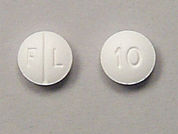Lexapro
Lexapro generic name: Escitalopram Oxalate
What is Lexapro used for?
This medication is used to treat certain mental/mood disorders (such as depression, anxiety). Escitalopram belongs to a class of drugs known as selective serotonin reuptake inhibitors (SSRIs). It works by helping to restore the balance of a certain natural substance (serotonin) in the brain.
CHEMICAL NAME
DRUG TYPE
DepressionLexapro Prices
Searching for the lowest prices
What does Lexapro look like?
View all Lexapro Image Information (3)Lexapro Frequently Asked Questions
Read the Medication Guide and, if available, the Patient Information Leaflet provided by your pharmacist before you start taking escitalopram and each time you get a refill. If you have any questions, ask your doctor or pharmacist.
Take this medication by mouth with or without food as directed by your doctor, usually once daily in the morning or evening. The dosage is based on your medical condition, response to treatment, age, and other medications you may be taking. Be sure to tell your doctor and pharmacist about all the products you use (including prescription drugs, nonprescription drugs, and herbal products).
If you are taking the capsule form of this medication, swallow the capsules whole. Do not open, crush, or chew the capsules.
If you are using the liquid form of this medication, carefully measure the dose using a special measuring device/spoon. Do not use a household spoon because you may not get the correct dose.
To reduce your risk of side effects, your doctor may direct you to start taking this drug at a low dose and gradually increase your dose. Follow your doctor's instructions carefully. Do not increase your dose or use this drug more often or for longer than prescribed. Your condition will not improve any faster, and your risk of side effects will increase. Take this medication regularly to get the most benefit from it. To help you remember, take it at the same time each day.
Keep taking this medication even if you feel well. Do not stop taking this medication without consulting your doctor. Some conditions may become worse when this drug is suddenly stopped. Also, you may experience symptoms such as mood swings, headache, tiredness, sleep changes, and brief feelings similar to electric shock. To prevent these symptoms while you are stopping treatment with this drug, your doctor may reduce your dose gradually. Consult your doctor or pharmacist for more details. Report any new or worsening symptoms right away.
It may take 1 to 2 weeks to feel a benefit from this drug and 4 weeks to feel the full benefit of this medication. Tell your doctor if your condition does not get better or if it gets worse.
IMPORTANT: HOW TO USE THIS INFORMATION: This is a summary and does NOT have all possible information about this product. This information does not assure that this product is safe, effective, or appropriate for you. This information is not individual medical advice and does not substitute for the advice of your health care professional. Always ask your health care professional for complete information about this product and your specific health needs.


